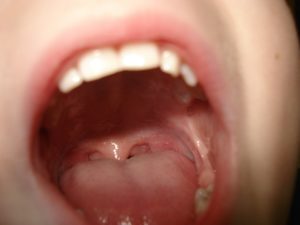Swallowing – Episode 112

The 3 Phases of Swallowing
Oral Phase
This phase includes chewing and saliva mixing with the food to form a bolus (a little glob of mashed up food). Then the tongue moves the bolus towards the back of the mouth. The tongue starts by pressing against the hard palate behind the front teeth. Then the sides of the tongue raise up to also press against the hard palate inside the teeth. At this point, the bolus has nowhere to go except towards the back of the throat.
Pharyngeal Phase
The vocal folds in the larynx close to keep food out. The larynx also moves up as the epiglottis covers it to seal off the airway. Then the soft palate and uvula move up and close off the nasal passage So now there is only one way out.
Esophageal Phase
The bolus moves into the esophagus (because it is the only open path). The esophageal muscles contract from top to bottom (this waving, rhythmic muscle movement is called peristalsis) to push the bolus into the stomach.
Swallowing Reflex
There are sensory receptors in the pharynx and tongue that receive touch signals. When they are touched by a bolus, the signals are sent to the brain stem and the return signal results in involuntary and automatic movements of the larynx and epiglottis. This is a good thing since swallowing is a very rhythmic process and you want food and drink to continue going in the correct direction.
This reflex cannot be triggered by sticking your finger in your throat. You are more likely to trigger a gag reflex that way. The voluntary steps of swallowing must be initiated before the involuntary portion of the process takes over.
Weird Swallowing Scenarios
How do you swallow with your mouth open?
At the dentist, you are usually laying in the chair on your back and facing the ceiling. There are at least three tools and two hands in your mouth. Things in your mouth trigger saliva production. Also, generally one of the tools the dentist is using is emitting water. The natural reflex when you have to hold your mouth open for a long time is to bring the back of the tongue and the soft palate together. This seals off the throat and allows you to still breathe through your nose. The liquid in your mouth plus gravity creates a puddle at the seal of your tongue and soft palate. Because the touch sensors to trigger your swallowing reflex are also in this area, it is likely you begin to panic because if they don’t hurry and use the suctioning straw to remove the liquid, you’re going to swallow!
Do you swallow in your sleep?
A study was done to find that the only times you swallow while sleeping is during arousal and during REM. My logical deduction regarding why is that when you’re aroused or in one of the more shallow phases of sleep, that is when you can voluntarily move – roll over, adjust the bedding, and swallow. During REM sleep, most people will experience sleep paralysis, so whatever exciting things are happening in their brain, the body is not likely to act it out. Because the brain cannot tell if a dream is real or imaginary, the feeling solicited can trigger hormones secretions and saliva production. Increased saliva, just like in the dentist scenario, can trigger swallowing.
Connect with me
Support us on Patreon
Join the Pharmacist Answers Podcast Community on Facebook
Subscribe: iTunes, Stitcher, GooglePlay, TuneIn Radio
Music Credits: Up In My Jam (All Of A Sudden) by – Kubbi https://soundcloud.com/kubbiCreative Commons — Attribution-ShareAlike 3.0 Unported— CC BY-SA 3.0 http://creativecommons.org/licenses/b…Music provided by Audio Library https://youtu.be/tDexBj46oNI




